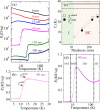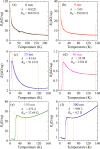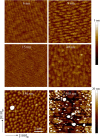Film-thickness-driven superconductor to insulator transition in cuprate superconductors
- PMID: 32094455
- PMCID: PMC7039923
- DOI: 10.1038/s41598-020-60037-y
Film-thickness-driven superconductor to insulator transition in cuprate superconductors
Abstract
The superconductor-insulator transition induced by film thickness control is investigated for the optimally doped cuprate superconductor La1.85Sr0.15CuO4. Epitaxial thin films are grown on an almost exactly matched substrate LaAlO3 (001). Despite the wide thickness range of 6 nm to 300 nm, all films are grown coherently without significant relaxation of the misfit strain. Electronic transport measurement exhibits systematic suppression of the superconducting phase by reducing the film thickness, thereby inducing a superconductor-insulator transition at a critical thickness of ~10 nm. The emergence of a resistance peak preceding the superconducting transition is discussed based on the weak localization. X-ray photoelectron spectroscopy results show the possibility that oxygen vacancies are present near the interface.
Conflict of interest statement
The authors declare no competing interests.
Figures







References
Grants and funding
- 2016R1A5A1008184/National Research Foundation of Korea (NRF)
- 2017R1A3B1023686/National Research Foundation of Korea (NRF)
- 2016R1A5A1008184/National Research Foundation of Korea (NRF)
- 2017R1A3B1023686/National Research Foundation of Korea (NRF)
- 2016R1A5A1008184/National Research Foundation of Korea (NRF)
LinkOut - more resources
Full Text Sources
Research Materials

